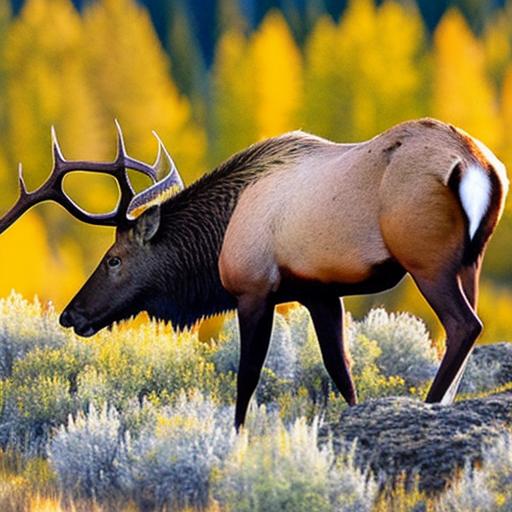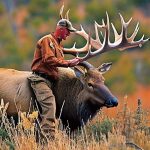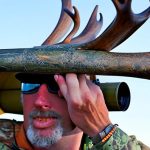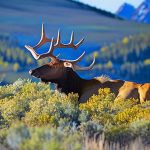Your cart is currently empty!

Exploring the Best Elk Units in Idaho: A Guide for Hunters and Wildlife Enthusiasts

Elk hunting in Idaho is a popular and thrilling outdoor activity that attracts hunters from all over the country. With its vast wilderness areas and diverse landscapes, Idaho offers some of the best elk hunting opportunities in the United States. Whether you are a seasoned hunter or a beginner, Idaho provides a unique and challenging experience for all.
Idaho is known for its large elk population, with an estimated 107,000 elk in the state. The state’s rugged terrain, dense forests, and open meadows provide ideal habitat for elk to thrive. This abundance of elk makes Idaho a prime destination for hunters looking to pursue these majestic animals.
Key Takeaways
- Elk hunting is a popular activity in Idaho, with a large population of elk and diverse hunting units.
- Understanding elk behavior and habitat is crucial for a successful hunt, including their feeding and mating patterns.
- The top elk hunting units in Idaho include the Sawtooth, Middle Fork, and Selway-Bitterroot Wilderness areas.
- Planning ahead for your elk hunting trip is important, including obtaining necessary licenses and permits and scouting the area beforehand.
- Essential gear for elk hunting in Idaho includes a quality rifle, binoculars, and appropriate clothing and footwear.
Understanding Elk Behavior and Habitat in Idaho
To have a successful elk hunting trip in Idaho, it is important to understand the behavior and habitat of these animals. Elk in Idaho are typically found in mountainous regions, where they can find ample food sources and cover. They are social animals that live in herds, with bulls, cows, and calves all staying together.
During the summer months, elk can be found at higher elevations where they graze on grasses and other vegetation. As the weather gets colder, they move to lower elevations in search of food and shelter. Understanding these patterns can help hunters locate elk during different seasons.
Scouting is an essential part of elk hunting in Idaho. By spending time in the field before your hunt, you can familiarize yourself with the area and look for signs of elk activity such as tracks, droppings, and rubs on trees. Pay attention to food sources such as meadows and water sources as these are likely areas where elk will congregate.
Top Elk Hunting Units in Idaho: An Overview
Idaho is divided into several hunting units, each with its own regulations and management strategies. Some of the top elk hunting units in Idaho include Unit 1, Unit 27, and Unit 39. These units are known for their high elk populations and offer a good chance of success for hunters.
Unit 1, located in northern Idaho, is known for its large bull elk and offers a mix of public and private land hunting opportunities. Unit 27, located in central Idaho, is known for its rugged terrain and challenging hunting conditions. It is home to a large number of elk and offers a wilderness hunting experience. Unit 39, located in southeastern Idaho, is known for its trophy bull elk and offers a mix of forested areas and open meadows.
These units are popular among hunters due to their high success rates and the opportunity to harvest mature bulls. However, it is important to note that these units can be crowded during peak hunting seasons, so it is advisable to plan your trip accordingly.
Planning Your Elk Hunting Trip in Idaho
| Planning Your Elk Hunting Trip in Idaho | |
|---|---|
| Best time to hunt | September to November |
| Required licenses and tags | Elk tag, hunting license, and a habitat fee |
| Cost of licenses and tags | Varies depending on residency and type of tag |
| Recommended hunting areas | Frank Church Wilderness, Selway-Bitterroot Wilderness, and Sawtooth Wilderness |
| Accommodations | Camping, cabins, and lodges are available near hunting areas |
| Equipment needed | Rifle or bow, appropriate clothing and footwear, binoculars, and a hunting knife |
| Guided hunting options | Several outfitters and guides are available for hire |
Planning an elk hunting trip in Idaho requires careful consideration and preparation. It is important to start planning well in advance to ensure you have all the necessary permits, licenses, and equipment.
First, determine the dates of the hunting season in the unit you plan to hunt. Elk hunting seasons in Idaho typically run from late August to early December, with different seasons for archery, rifle, and muzzleloader hunts. Once you have determined the dates, check the availability of tags and permits for the specific unit you plan to hunt.
Next, consider your mode of transportation and accommodations. Idaho has a vast wilderness area, so it is important to have a reliable vehicle that can handle rough terrain. Additionally, consider whether you will be camping or staying in a nearby town during your hunt.
Lastly, make sure you have all the necessary gear and equipment for your elk hunting trip. This includes firearms or archery equipment, appropriate clothing and footwear, camping gear if needed, and other essential items such as binoculars, range finders, and game bags.
Essential Gear and Equipment for Elk Hunting in Idaho
When it comes to elk hunting in Idaho, having the right gear and equipment is crucial. Here is a list of essential items you will need for your hunt:
1. Firearms or Archery Equipment: Depending on your preference, you will need a reliable rifle or bow for elk hunting. Make sure you are proficient with your chosen weapon and practice regularly before your hunt.
2. Clothing and Footwear: Dressing appropriately for the weather conditions is important for a comfortable and successful hunt. Layering is key, as temperatures can vary throughout the day. Invest in quality hunting clothing that is durable, waterproof, and scent-resistant. Additionally, choose footwear that provides good ankle support and traction for navigating rugged terrain.
3. Optics: A good pair of binoculars is essential for spotting elk from a distance. Look for binoculars with a magnification of at least 8x or 10x and a wide field of view. A spotting scope can also be useful for observing elk in more detail.
4. Backpack: A sturdy backpack is necessary for carrying your gear, water, food, and other essentials during your hunt. Look for a backpack with multiple compartments and adjustable straps for a comfortable fit.
5. Game Bags: Game bags are used to transport the meat after a successful hunt. Look for lightweight, breathable bags that are large enough to hold an elk quarter.
6. Calls: Elk calls can be effective in attracting elk during the rutting season. There are various types of calls available, including bugles, cow calls, and grunt tubes. Practice using these calls before your hunt to ensure you are proficient.
7. GPS or Maps: Navigating through Idaho’s vast wilderness can be challenging, so it is important to have a reliable GPS device or maps to help you find your way.
Hunting Techniques and Strategies for Elk in Idaho

Elk hunting in Idaho requires a combination of patience, skill, and knowledge of elk behavior. Here are some hunting techniques and strategies that can increase your chances of success:
1. Spot and Stalk: This technique involves glassing for elk from a distance and then moving in closer for a shot. Use your binoculars or spotting scope to scan the landscape for elk. Once you spot a herd, plan your approach carefully, taking advantage of cover and wind direction.
2. Calling: During the rutting season, elk are more vocal and responsive to calls. Bugling can be effective in attracting bulls, while cow calls can be used to lure in cows and calves. Practice different calls and learn to mimic the sounds of elk to increase your chances of success.
3. Ambush Hunting: Setting up an ambush near known elk travel routes or feeding areas can be an effective strategy. Look for signs of elk activity such as tracks, droppings, and rubs on trees. Set up downwind of these areas and wait patiently for elk to come within range.
4. Hunting with a Partner: Hunting with a partner can increase your chances of success by covering more ground and increasing your chances of spotting elk. Coordinate your movements and communicate effectively to avoid spooking elk.
5. Glassing: Spend time glassing from vantage points such as ridges or high points to spot elk from a distance. Look for movement or dark shapes against the landscape. Once you spot elk, plan your approach carefully.
Best Times to Hunt Elk in Idaho
The best times to hunt elk in Idaho depend on various factors such as weather conditions, hunting pressure, and the behavior of the animals. Here are some general guidelines to consider when choosing the best time to hunt elk in Idaho:
1. Rutting Season: The rutting season is when bulls are most active and vocal, making it an exciting time to hunt elk. This typically occurs in September and early October. During this time, bulls are more responsive to calls and can be easier to locate.
2. Early Season: The early season, which usually starts in late August, can be a good time to hunt elk as they are still in their summer patterns. Elk can be found at higher elevations where they feed on grasses and other vegetation.
3. Late Season: The late season, which usually occurs in November and December, can be challenging due to colder temperatures and snowfall. However, elk are more concentrated at lower elevations during this time, making them easier to locate.
4. Weather Conditions: Pay attention to weather conditions when planning your hunt. Elk are more active during cooler temperatures, so hunting during a cold front or after a rainstorm can increase your chances of success.
5. Hunting Pressure: Consider the hunting pressure in the unit you plan to hunt. If a unit is heavily hunted, elk may become more wary and difficult to locate. Consider hunting during weekdays or in less popular units to avoid crowds.
Hunting Regulations and Licensing in Idaho
Before you go elk hunting in Idaho, it is important to familiarize yourself with the state’s hunting regulations and licensing requirements. Here are some key points to consider:
1. Licensing: To hunt elk in Idaho, you will need a valid hunting license and an elk tag for the specific unit you plan to hunt. Tags are limited and allocated through a lottery system, so it is important to apply early.
2. Nonresident Fees: Nonresidents are required to pay higher fees for hunting licenses and tags compared to residents. Make sure to check the current fees and regulations for nonresidents before applying.
3. Hunter Education: Idaho requires all hunters born after January 1, 1975, to complete a hunter education course before purchasing a hunting license. This course covers firearm safety, hunting ethics, and wildlife conservation.
4. Bag Limits: Idaho has specific bag limits for elk, which vary depending on the unit and the type of hunt. Make sure to familiarize yourself with the bag limits for the unit you plan to hunt.
5. Reporting Requirements: After a successful hunt, hunters are required to report their harvest within 10 days. This can be done online or by phone. Failure to report can result in penalties and loss of hunting privileges.
Conservation and Preservation Efforts for Elk in Idaho
Idaho has a strong commitment to the conservation and preservation of its elk population. The state’s wildlife management agencies work closely with hunters, landowners, and conservation organizations to ensure the long-term sustainability of elk populations.
Hunters play a crucial role in elk conservation by participating in regulated hunts and adhering to hunting regulations. By harvesting mature bulls and managing herd populations, hunters help maintain a healthy balance between elk and their habitat.
Additionally, hunters can contribute to elk conservation efforts by supporting organizations such as the Rocky Mountain Elk Foundation (RMEF). RMEF works to conserve elk habitat, restore degraded habitats, and enhance public access for hunting and other outdoor activities.
Other Wildlife and Outdoor Activities in Idaho
While elk hunting is a major draw for outdoor enthusiasts in Idaho, the state offers a wide range of other wildlife and outdoor activities to enjoy. From fishing in pristine rivers and lakes to hiking through scenic mountain ranges, Idaho is a paradise for outdoor enthusiasts.
Idaho is home to diverse wildlife species such as mule deer, whitetail deer, black bears, mountain lions, and various bird species. Birdwatching, wildlife photography, and nature walks are popular activities for those who want to experience the beauty of Idaho’s natural landscapes.
In addition to hunting and wildlife viewing, Idaho offers opportunities for camping, backpacking, horseback riding, mountain biking, and rafting. The state’s national parks, wilderness areas, and scenic byways provide endless opportunities for outdoor adventure.
Elk hunting in Idaho offers a thrilling and rewarding experience for hunters of all skill levels. With its abundant elk populations, diverse landscapes, and commitment to conservation, Idaho is a top destination for elk hunting. By understanding elk behavior, scouting for prime hunting areas, and planning your trip carefully, you can increase your chances of a successful hunt. So pack your gear, plan your trip, and get ready for an unforgettable elk hunting adventure in the beautiful state of Idaho.
If you’re interested in hunting in Idaho’s elk units, you may also want to check out this informative article on the best time to hunt squirrels in winter. It provides valuable tips and insights on how to maximize your chances of success during the colder months. Whether you’re a seasoned hunter or a beginner, this article will help you make the most of your squirrel hunting adventures. Read more here.
FAQs
What are Idaho elk units?
Idaho elk units are designated areas within the state of Idaho where elk hunting is allowed. These units are managed by the Idaho Department of Fish and Game.
How many elk units are there in Idaho?
There are 28 elk units in Idaho. Each unit has its own set of regulations and hunting seasons.
What is the purpose of elk units?
The purpose of elk units is to manage elk populations and provide hunting opportunities for hunters. By dividing the state into units, the Idaho Department of Fish and Game can better manage elk populations and ensure sustainable hunting opportunities.
How are elk units determined?
Elk units are determined based on a variety of factors, including elk population size, habitat quality, and hunting pressure. The Idaho Department of Fish and Game regularly reviews and adjusts elk unit boundaries and regulations to ensure sustainable elk populations and hunting opportunities.
What are the hunting regulations for elk units?
Hunting regulations for elk units vary depending on the unit. Hunters are required to have a valid hunting license and tag, and must follow specific regulations regarding hunting season dates, bag limits, and weapon restrictions. It is important for hunters to review the regulations for the specific elk unit they plan to hunt in.
Can non-residents hunt in Idaho elk units?
Yes, non-residents can hunt in Idaho elk units. However, non-residents are required to purchase a non-resident hunting license and tag, which are typically more expensive than resident licenses and tags. Non-residents may also be subject to additional regulations and restrictions.

Herb has been a longtime lover of the outdoors. Whether it be hunting, camping, fishing or just getting outside to reset. Proud father and animal lover. Bourbon anyone?

by
Tags:
Comments

Categories
- Big Game Hunting (301)
- Deer (202)
- Reviews (3)
- Shooting (16)
- Slingshot (1)
- Small Game Hunting (42)
- Upland Hunting (126)
- Waterfowl Hunting (3)





Leave a Reply